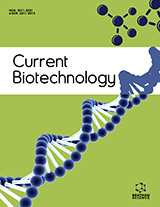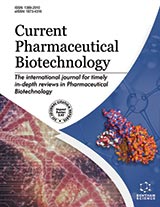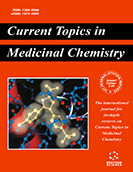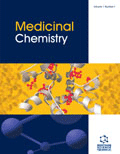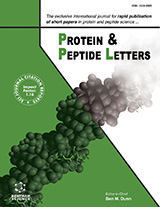Abstract
A bioflocculant - producing bacterium was isolated from water samples collected from the Vaigai river and was identified as Klebsiella sp. by morphological and biochemical characteristics. Chemical analysis of the purified bioflocculant indicated that it was a sugar-protein derivative, composed of sugar (76.83%, w/w) and protein (23.17%, w/w). Infrared spectrophotometry revealed that the bioflocculant contains carboxyl, hydroxyl and amino groups as structural components. Scanning electron microscopy (SEM) of the purified bioflocculant showed that it has an irregular, coarse-grained structure connected in netted textures. The concentration of bioflocculant produced after 48 h of cultivation was 0.73 g/L. At the optimal concentration, the bioflocculant caused 91.28% more settling of kaolin than the control in 5 min.
Keywords: Bioflocculant; Klebsiella sp., Flocculating activity, Biochemical Analysis, FTIR, SEM, Kaolin
Current Biotechnology
Title:Production and Characterization of a Novel Bioflocculant from Klebsiella sp.
Volume: 2 Issue: 1
Author(s): L. Muthulakshmi and H. Nellaiah
Affiliation:
Keywords: Bioflocculant; Klebsiella sp., Flocculating activity, Biochemical Analysis, FTIR, SEM, Kaolin
Abstract: A bioflocculant - producing bacterium was isolated from water samples collected from the Vaigai river and was identified as Klebsiella sp. by morphological and biochemical characteristics. Chemical analysis of the purified bioflocculant indicated that it was a sugar-protein derivative, composed of sugar (76.83%, w/w) and protein (23.17%, w/w). Infrared spectrophotometry revealed that the bioflocculant contains carboxyl, hydroxyl and amino groups as structural components. Scanning electron microscopy (SEM) of the purified bioflocculant showed that it has an irregular, coarse-grained structure connected in netted textures. The concentration of bioflocculant produced after 48 h of cultivation was 0.73 g/L. At the optimal concentration, the bioflocculant caused 91.28% more settling of kaolin than the control in 5 min.
Export Options
About this article
Cite this article as:
Muthulakshmi L. and Nellaiah H., Production and Characterization of a Novel Bioflocculant from Klebsiella sp., Current Biotechnology 2013; 2 (1) . https://dx.doi.org/10.2174/2211550111302010009
| DOI https://dx.doi.org/10.2174/2211550111302010009 |
Print ISSN 2211-5501 |
| Publisher Name Bentham Science Publisher |
Online ISSN 2211-551X |
 29
29
- Author Guidelines
- Bentham Author Support Services (BASS)
- Graphical Abstracts
- Fabricating and Stating False Information
- Research Misconduct
- Post Publication Discussions and Corrections
- Publishing Ethics and Rectitude
- Increase Visibility of Your Article
- Archiving Policies
- Peer Review Workflow
- Order Your Article Before Print
- Promote Your Article
- Manuscript Transfer Facility
- Editorial Policies
- Allegations from Whistleblowers
- Announcements
Related Articles
-
The Contribution of Transcriptomics to Biomarker Development in Systemic Vasculitis and SLE
Current Pharmaceutical Design New Perspectives on Acetaminophen
Current Cardiology Reviews Targeting Glioblastoma Stem Cells: Cell Surface Markers
Current Medicinal Chemistry Druggability of Mortalin for Cancer and Neuro-Degenerative Disorders
Current Pharmaceutical Design Computational Study of Nanosized Drug Delivery from Cyclodextrins, Crown Ethers and Hyaluronan in Pharmaceutical Formulations
Current Topics in Medicinal Chemistry Epithelial Organotypic Cultures: A Viable Model to Address Mechanisms of Carcinogenesis by Epitheliotropic Viruses
Current Topics in Medicinal Chemistry Electrohydrodynamic Preparation of Nanomedicines
Current Topics in Medicinal Chemistry Functional Food: Product Development and Health Benefits
Recent Patents on Engineering Stable Synthetic Bacteriochlorins: Potent Light-Activated Anti-Cancer Drugs
Current Organic Chemistry How to Advise Aspirin Use in Patients Who Need NSAIDs
Current Pharmaceutical Design Reprofiling of Troglitazone Towards More Active and Less Toxic Derivatives: A New Hope for Cancer Treatment?
Current Topics in Medicinal Chemistry Synthesis and In Vitro Anticancer Activity of Novel 2-((3-thioureido)carbonyl) phenyl Acetate Derivatives
Letters in Drug Design & Discovery The Role of Thiols and Disulfides on Protein Stability
Current Protein & Peptide Science Prognostic and Predictive Biomarkers in Cancer
Current Cancer Drug Targets Sub Cellular Organelles-targeting Photo Dynamic Therapy (PDT)
Mini-Reviews in Organic Chemistry Deep Transfer Learning for COVID-19 Prediction: Case Study for Limited Data Problems
Current Medical Imaging Tolfenamic Acid Interrupts the De Novo Synthesis of the β-Amyloid Precursor Protein and Lowers Amyloid Beta Via a Transcriptional Pathway
Current Alzheimer Research A Highly Sensitive Fluorimetric Method for Determination of Cinacalcet Hydrochloride in Tablets and Plasma via Derivatization with 7-Chloro-4- nitrobenzoxadiazole
Current Analytical Chemistry Proteomics Approaches to Elucidate Oncogenic Tyrosine Kinase Signalingin Myeloid Malignancies
Current Pharmaceutical Biotechnology Computational Studies Applied to Anti-inflammatory Drug Discovery: A Review
Current Organic Chemistry


